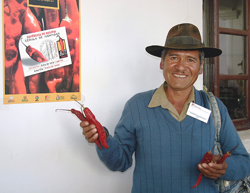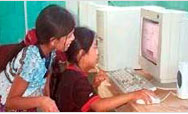You are here » Home » Telling Our Story
Success Story
Red chili pepper program increases rural incomes
Red Chilies Become Hot Commodity

| |
Photo: USAID/Walter Mur
|
|
A farmer shows a sample of the chili peppers he sold at the International Red Chili Pepper Festival in Padilla, Bolivia.
A poverty alleviation program in Bolivia’s poorest regions helps farmers improve the quality of their agricultural products, revitalize their local economy, and find opportunities to increase revenue.
|
One Friday in July, the residents of Padilla, a remote town in southern rural Bolivia, began their day with a little more spice than usual. It was the first day of their fourth annual International Red Chili Pepper Festival. The event attracted local producers and their families, owners of trade firms, and entrepreneurs from neighboring Argentina and Peru, who gathered together to make contacts and explore business opportunities. As a result, farmers sealed new deals to sell one hundred tons of Bolivian red chili peppers, with a total value of more than $100,000.
The festival is the public face of a joint program implemented by USAID and the Government of Bolivia to promote market access for impoverished farmers. The project improves production processes and helps farmers find trade opportunities for nontraditional agricultural products from Bolivia.
Red chili peppers are usually produced in this rural area with traditional farming practices. The methods for handling peppers, excessive use of chemical fertilizers, and lack of marketing skills can result in both poor harvests and poor sales. Thanks to technical assistance and training, more than 75 percent of the crop now makes its way to local and export markets, resulting in much needed revenue for the farmers. The income of farmers in the program is now double the average income of rural workers in the region.
Padilla is located in one of the most impoverished regions of Bolivia, with few natural resources and poor social and economic conditions. However, red chili peppers from this region are prized for their flavor and, increasingly, for their quality. With USAID assistance, the chili crop has become a more valuable local resource that promises to change the lives of many farmers and boost local economic development. In addition, residents of Padilla are discovering that chili pepper production has the potential to bring other benefits to their town, such as tourism and related services for those attending the festival. With continued support from USAID, farmers in this region and throughout Bolivia are looking forward to a hot and spicy future filled with chilies, growth, and more cash.
Print-friendly version of this page (481kb - PDF)
Click here for high-res photo
Back to Top ^ | 

